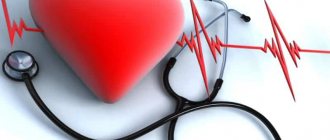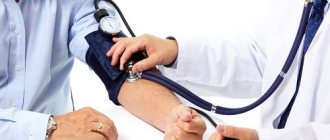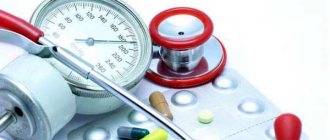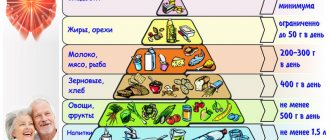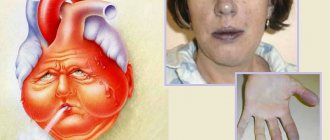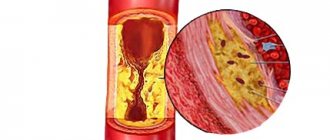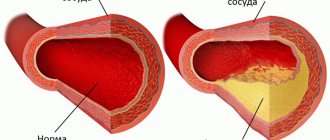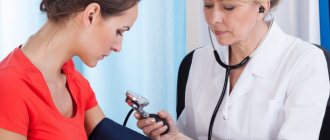Hypertension risks
Who may develop cardiovascular diseases? The following factors increase the risk of developing hypertension: genetic predisposition, chronic fatigue, sedentary lifestyle. Treatment of the cardiovascular system is required 3 times more often by sedentary people than by active people. What are the risks of developing hypertension?
- Stress. In most cases, hypertension is caused by increased levels of the stress hormone adrenaline. This hormone, when acting on the body, narrows the lumen of blood vessels. The result is an increase in the load on the heart, as the heart muscle pumps out more blood and pressure on the walls of blood vessels increases.
- Smoking. Doctors often treat hypertension in smokers. In patients with hypertension who cannot quit smoking, stroke and myocardial infarction are 50-70% more common.
- Diabetes. Many people are interested in the degree of risk of cardiovascular accidents. With insufficient secretion of the hormone insulin, metabolic disorders occur in the body. This can ultimately cause the deposition of a fat-like substance, cholesterol, on the artery wall, leading to the formation of atherosclerotic plaques and atherosclerosis.
- Obesity. The risk of grade 4 CVE (we'll look at what it is below) most often occurs due to excess weight. Fat can be deposited inside blood vessels and on the surface of organs. These accumulations narrow the artery, resulting in impaired blood flow in it. As a result, the cardiovascular system is subject to increased stress; the walls of blood vessels bulge, become thinner, and may rupture, which can lead to a stroke or heart attack.
Taking pills. This includes the use of appetite suppressants, high-hormonal oral contraceptives, anti-inflammatory drugs and some other medications. More often, hypertension develops in older women, smokers and overweight women who take oral contraceptives. If symptoms of cardiovascular disease occur, you should consult a cardiologist or gynecologist about the need to stop taking hormones. Excessive salt intake. Water balance in the body is regulated by sodium. When you consume large amounts of salty foods or salt, excess sodium and excess fluid are retained in the body, increasing blood pressure and creating swelling. In large doses, salt can lead to increased blood pressure. Then a diagnosis of hypertension is made. High cholesterol. Increased levels of cholesterol in the blood cause deposits of atherosclerotic plaques on the walls of blood vessels. Over time, the lumen of the artery becomes narrower, and the number of plaques increases, resulting in the development of atherosclerosis. Under the influence of this disease, the vessels of the systemic and pulmonary circulation are affected. Climax. Gonadal hormones have a significant influence with age. This is called menopausal hypertension. During postmenopause, women can be prescribed hormone replacement therapy if they did not have hypertension while taking COCs. However, this does not eliminate the need to monitor blood pressure. Age. As people age, there is a risk of stage 4 cardiovascular complications. We will tell you what this is further. Older people over 50 years of age need blood pressure therapy much more often than younger people, which is due to the deterioration of their cardiovascular system and its frequent exposure to atherosclerosis and other vascular diseases. Disturbed functioning of the endocrine and nervous systems. Hormones play one of the most important roles in regulating blood pressure. The greatest influence is exerted by the hormones of the pituitary gland, pancreas, thyroid gland, and adrenal glands. It is worth doing a hormonal test if a blood test shows normal cholesterol levels. Hypertension can be caused by hormones if relatives do not have CVD diseases. When confirming the diagnosis of hypertension, the specialist will also indicate the risk of stroke or heart attack in the next 10 years. There are four degrees of risk, depending on the stage of hypertension and the possibility of its development.
Carrying out diagnostics for hypertension of the fourth degree
As part of the diagnosis of arterial hypertension (ICD 10 code - I10-I15), the following procedures are performed:
In order to confirm the diagnosis of arterial hypertension, daily blood pressure monitoring is required. Based on the parameters of upper pressure and other examination procedures, the doctor makes a diagnosis.
Disability
IT IS IMPORTANT TO KNOW!
Shocking statistics! Hypertension is the most common disease of the cardiovascular system. It has been established that 20-30% of the adult population suffer from it. With age, the prevalence of the disease increases and reaches 50-65%. The consequences of high blood pressure are known to everyone: these are irreversible damage to various organs (heart, brain, kidneys, blood vessels, fundus of the eye). In later stages, coordination is impaired, weakness appears in the arms and legs, vision deteriorates, memory and intelligence are significantly reduced, and a stroke can be triggered. In order to avoid complications and operations, people, taught by bitter experience, use...
Read more "
After the patient undergoes a comprehensive examination of the body, the attending physician, if there are sufficient grounds, decides to refer the patient to a medical commission, which includes a board of physicians that has the authority to draw up a conclusion on the person’s incapacity for work due to the presence of a chronic disease. Hypertension of degree 2, risk 3, belongs to a group of similar pathologies and the patient actually has the right to receive the status of a disabled person. What disability group can be obtained for hypertension?
Third disability group.
In most cases, patients are assigned disability group 3, which entitles them to receive social assistance from the state based on the amount of the minimum pension.
These are payments intended to ensure that a hypertensive patient has the opportunity to purchase medications that will quickly relieve a hypertensive crisis, or to keep it under constant control by regularly taking medications. Patients with disability group 3 and arterial hypertension of degree 2, risk 3, have the right to work, but the list of types of employment is significantly limited, since there is a high probability that the person will suddenly become ill, feel dizzy, or experience a jump in blood pressure with further loss of consciousness. Therefore, after receiving the status of a disabled person of group 3, a hypertensive person cannot be allowed to work related to the performance of the following job duties:
- installation of metal connections and work with various objects on high-rise buildings and structures;
- driving vehicles, mechanisms, equipment and installations that belong to the category of increased danger, and loss of control over them can lead to an emergency situation;
- performing welding work using electric and gas equipment;
- mental employment, which involves intense mental activity throughout the working day;
- specialties related to psycho-emotional stress.
Patients with stage 2 hypertension with risk 3, who have received group 3 disabled status, are recommended to lead a measured lifestyle and work in positions that balance mental activity and minor physical activity.
Second disability group.
This disability group can also be assigned to a patient with arterial hypertension of degree 2 with risk 3, but only if the examination results revealed irreversible changes in the tissues of the following organs:
- kidneys;
- heart muscle;
- eyeball;
- brain;
- vessel walls.
Symptoms
The symptoms of the disease are complex; it is no coincidence that experts call hypertension the “silent killer.” The patient does not feel increased blood pressure. Especially if the disease occurs latently over a long period, the symptoms are masked.
There are common symptoms that patients simply do not pay attention to:
- weakness, malaise;
- fast fatiguability;
- slight nausea;
- sudden headaches;
- swelling of the hands and face (especially in the morning);
- in older people – tinnitus, dizziness (staggering, swaying);
- cardiopalmus;
- facial redness, sweating.
In this condition, a hypertensive crisis is possible - a sharp rise in pressure, a sudden deterioration in the condition.
Characteristics of this condition:
- acute headache, dizziness;
- possible fainting;
- nausea to vomiting;
- blurred vision (veil, “floaters” before the eyes);
- heaviness in the chest;
- discomfort and pain in the heart area;
- dyspnea;
- trembling and chills;
- frequent urination;
- sudden hot flashes (sweating).
Important! Clinical symptoms can be relieved immediately only under the supervision of a physician in order to prevent the rapid development of complications (pulmonary edema, heart attack, etc.).
It is necessary to understand that high blood pressure does not normalize on its own, and many people do not even know what their blood pressure is.
Experts recommend that everyone over 45-50 years old measure their blood pressure on their own, at least once every day. per month, immediately after waking up, without getting out of bed.
If, under the most optimal conditions (at rest), the pressure is higher than the specified values, you should immediately go to the doctor.
Hypertension risk 4
This group is at very high risk, exceeding 30%!
The third degree of hypertension, in which blood pressure is 180/110 mmHg. pillar and above, of course requires close attention, both from the doctor and the sick person himself. The patient should be trained in all psychophysical methods of reducing high blood pressure and try to resort to their help if necessary.
In addition, people diagnosed with hypertension with risk 4 should lead a consistently healthy lifestyle, fundamentally avoid the use of intoxicants and being in noisy company. He must certainly cultivate the psychophysical technique, placing emphasis on both its physical and psychological parts.
The most accessible means of physical activity should be long walking, for a whole hour, with strict observance of all the commandments of self-control.
The so-called risk of severe cardiovascular diseases should not shock the patient. He must understand that this notorious 30% is nothing more than the most ordinary figure, created artificially with the aim of finally zombifying him.
It is these 30% that make him completely disappointed in the capabilities of his own body, accepting treatment with chemicals as a gift from God, which, by the way, will never lead to recovery, but only to the real realization of these percentages.
It is important to understand that any risk is, first of all, the relative or absolute probability of the occurrence of an event, a complication of a disease, or its outcome. But this probability is just a mathematical figure that has nothing to do with the natural biosocial life of a person
What are the chances of developing cardiovascular diseases, and even for some period of life? This means that a person is brainwashed into obligatory acquisition of the disease over the next ten years of life. Mandatory! It’s almost like in chirology, a specialist who peers intently into the client’s palm suddenly declares that you have exactly so many years left to live!
And this prophecy almost always works as an encore: clients, without small exceptions, are sure to invest in this ill-fated time - the formed dominant will never, under any pretext, leave the limits of consciousness, as well as the subconscious, reliably storing this ill-fated information.
This is already like a code of life and even death, which will guide a person only in an artificially created way. These 10 remaining years will loom before a person’s eyes. This will already be an algorithm, first of all, for biological life, because social life, as well as spiritual life, turns into a martyr’s wait for the end of these ten years.
But these 10 years may end earlier, but it is unlikely to stretch over a longer period of time, given an established lifestyle.
This dominant can only be removed from the consciousness-subconscious through one’s own efforts, by dramatically changing the algorithm of life that has been developed over the years, saturating it with psychophysical attitudes. At this time, it is simply necessary to be ironic about the said 10 years, and then they will certainly sink into oblivion, leaving only a bitter memory as a farewell.
In no way can you, as a magician, predict the likelihood of complications, some illnesses, and especially deaths - this information will certainly boomerang on the creative authors themselves.
Causes and signs of the disease
The fact of the presence of grade 3 hypertension eloquently indicates that the disease is clearly advanced. The patient was either poorly treated or frivolously refused treatment in the earlier stages of the disease. Unfortunately, cases where patients ignore symptoms indicating that they are developing arterial hypertension are far from isolated.
In addition, the disease in such patients steadily progresses if unfavorable factors influence:
- overweight;
- passive lifestyle;
- age after 40 years;
- frequent exposure to stress;
- alcohol abuse, smoking;
- hereditary predisposition.
With stage 3 hypertension, risk 3 pathology usually quickly worsens to risk 4. The following painful symptoms become constant “life companions”:
- sudden, often unmotivated jumps in blood pressure;
- severe headaches;
- sharp pain in the heart area;
- “floaters”, darkening of the eyes;
- dizziness, deterioration of coordination of movements;
- tachycardia (rapid heartbeat);
- insomnia;
- memory impairment;
- partial loss of sensation in the toes and hands;
- swelling of the face and limbs.
All these symptoms are a consequence of pathological blood pressure above 180 mmHg. Hypertensive crises are not uncommon in stage 3 hypertension with a risk of stage 4. They are especially difficult. During such attacks, the patient is overcome by acute symptoms of the disease, including loss of consciousness.
What does the risk of cardiovascular complications mean and its relationship with hypertension
What MTR is in medicine can be understood by deciphering the term.
This is the presence of cardiovascular deterioration in a person against the background of some diseases, including hypertension. What is the relationship between RSSO and hypertension? The problem is not the manifestation of its symptoms, but the complications that provoke the disease, which are expressed in acute disorders of the blood vessels, kidneys, heart and brain.
When diagnosing hypertensive pathology, it is important for specialists to correctly identify the patient’s risk factors and determine how much they contribute to the aggravation of the disease.
The relationship between the stages of hypertension and the risks present is necessarily indicated in the final diagnosis, allowing the condition of a hypertensive patient to be assessed with maximum accuracy and the further clinical picture to be predicted.
First (soft) stage
The pressure rises to 140/90-159/99 units. Features of the flow:
- Blood pressure surges are short-term and normalize on their own.
- Does not require special antihypertensive therapy.
Has no risk factors.
Second (moderate) stage
The blood count reaches 160/100-179/109 units. The main difference is that elevated arterial values are less and less likely to return to normal parameters on their own.
Peculiarities:
- The duration of blood pressure stay within the normal range is gradually reduced.
- The patient periodically experiences headaches, stabbing or pressing discomfort in the heart area, radiating to the left arm, and other symptoms.
- It is necessary to take antihypertensive medications.
Third (severe) stage
The pressure remains stably at a high level and exceeds 180/110 units. Such blood pressure numbers indicate the malignant nature of the pathology, which is difficult to treat with medication.
The functioning of target organs is disrupted:
- Hearts.
- Kidney.
- Organs of vision.
- Brain.
When arterial parameters decrease, a person feels painful weakness.
When the diagnosis indicates risk 4
Diagnosing a patient with hypertension, stage 2, stage 2, risk 4, presupposes that the patient has the following types of concomitant diseases that significantly aggravate the course of arterial hypertension:
- Diabetes.
It develops as a result of the fact that the pancreas does not cope with its physiological function, aimed at producing a sufficient volume of the hormone insulin, which entails an increase in the level of glucose in the patient’s blood, the accumulation of sugar crystals in the main vessels and their gradual clogging. This factor directly leads to increased blood pressure.
- Atherosclerosis of arteries and veins.
This pathology can develop as a result of a person’s abuse of bad habits, hereditary predisposition, chemical poisoning or obesity. With vascular atherosclerosis, the lumen of the arteries narrows, causing blood to flow at a slower pace. In this regard, there is a risk of the formation of excess pressure inside the arteries with the further development of a hypertensive crisis.
- Cardiac ischemia.
Symptoms of stage 4 hypertension
Many patients have an isolated type of systolic hypertension, which is why it is asymptomatic. The main symptoms, characteristic of many pathological processes, are, as a rule, a lethargic state of a person, the presence of dizziness, an audible noise effect and a prolonged headache. Other patients may react differently to increased blood pressure, for example, they may experience the following signs of arterial hypertension:
Other types of illness
In medical practice, rarer types of headache are also encountered. A brief description of them is presented below:
- White coat hypertension. One of the specific forms of pathology. It is characterized by an increase in blood pressure during the period of its measurement. Its increase is due to stress and fear of specialists in white coats. Moreover, when independently measuring pressure, normal values are revealed.
- False. This form is caused by the simultaneous use of antihypertensive drugs with other drugs. They help reduce the effectiveness of antihypertensive medications, as a result of which there is a stable maintenance of high blood pressure levels. The most undesirable drugs taken during the treatment of hypertension include corticosteroids.
- Chronic. In the chronic form of the pathology, the observed therapy does not lead to the patient’s recovery. The patient is forced to take medications that normalize blood pressure throughout his life. Without drug support, the patient's condition worsens and the risk of complications increases.
- Labile. This type is characterized by a constant or periodic increase in blood pressure up to a limit of 140. When a pathology is detected, it is necessary to immediately begin medical therapy, since there is a high probability of transition of labile hypertension to a more severe form.
- Borderline. This type of disease is characterized by a condition preceding hypertension. The patient experiences changes in blood pressure levels - from normal to critically high. Moreover, these disorders occur without any pathological changes in the functioning of the heart muscle and other organs.
- Night. Pathology that is most difficult to control. This is due to the fact that the patient’s blood pressure increases only at night, while during the day the body “rests.” The main cause of this form of the disease is severe disturbances in the functioning of the cardiovascular system.
- Hereditary. This form of hypertension affects patients who have a genetic predisposition to high blood pressure. Most often, the disease is transmitted through the maternal line; in more rare cases, the pathology is transmitted to the child from both parents.
The danger of the disease lies in its hidden form; at a young age it often goes unnoticed. Serious health problems only appear in later life. Initially, high blood pressure is mistakenly taken as a symptom of vegetative-vascular dystonia.
- Metabolic. A form of hypertension accompanied by metabolic syndrome. Signs of this syndrome include:
- increased levels of sugar and triglycerides in the blood;
- impaired carbohydrate metabolism. High blood pressure is especially dangerous in obesity. The risk of heart attack, stroke, ischemia, and heart failure increases.
obesity;
Moreover, pathology occurs regardless of the dosage of these medications. A characteristic sign of a resistant form of hypertension is that despite powerful complex treatment, the pressure does not normalize.
Orthostatic hypotension
There is an increase in pressure for the following reason: when a person lies, the kidneys, pathologically lowered, compress the renal artery. This forms a functional type of stenosis. May be accompanied by fainting. In most cases, surgery is required to correct the problem.
Hypertension is very multifaceted. Has different types, types and stages requiring an individual therapeutic approach
It is important to remember that increased blood pressure is not normal. It is provoked by various pathologies occurring in the body
If this problem is left unattended, there is a high probability of severe consequences for human health. A fatal outcome cannot be ruled out.
Treatment
At stage 3 of the disease, doctors use long-acting medications that can control blood pressure throughout the day. Drugs are prescribed taking into account their effect on the patient’s age, target organs and concomitant diseases. The treatment regimen includes medications of the following groups:
- Diuretics – reduce blood pressure by removing excess fluid. From this group of drugs, Torasemide, Arifon and Indap are prescribed.
- ACE inhibitors interrupt the chain of processes leading to vasoconstriction. A quick effect can be obtained from Captopril, Enalapril, Perindopril.
- Beta blockers block the production of the hormones adrenaline and norepinephrine, which contribute to an increase in blood pressure. Anaprilin, Timolol and Bisoprolol have a good effect on the body of patients.
- Calcium antagonists - increasing the level of calcium in the blood causes the heart to contract faster. Medicines from this group reduce the amount of calcium ions and heart rate accordingly. The best representatives are Amlodipine, Felodipine and Cinnarizine.
- Centrally acting drugs - the effect is aimed at relaxing certain receptors in the brain responsible for vasoconstriction and heartbeat. The treatment regimen for hypertension includes Reserpine, Adelfan.
What is stage 4 hypertension?
The majority of the adult population of the world today suffers from high blood pressure, which makes itself felt not only in old age, but also earlier. Hypertension is considered to be a disease associated primarily with stress and physical activity.
With normal blood pressure 120–130/80–90 mmHg. it can increase to significant levels, leading to serious health problems, including death.
The disease is usually characterized as 1st, 2nd and 3rd degree depending on the level of increase in pressure indicators. But both pressure limits do not always increase; grade 4 hypertension is characterized by an increase in only the upper level.
- All information on the site is for informational purposes only and is NOT a guide to action!
- can give you an ACCURATE DIAGNOSIS !
- We kindly ask you NOT to self-medicate, but to make an appointment with a specialist !
- Health to you and your loved ones!
Hypertension, in which cardiac pressure increases significantly, but vascular pressure remains normal or even decreases slightly, is called isolated systolic. The pathology causes many more complications from the heart and brain than other forms.
It is also characterized by an increase in heart rate. Such large pressure drops occur due to the fact that the vessels lose their elasticity. This is most common for people over 60 years of age, and especially over 75.
While the diastolic pressure continues to remain within 90 mmHg. systolic can increase according to three degrees:
Fourth degree hypertension and its treatment
Some experts have the opinion that fourth-degree hypertension in the elderly can be left untreated or non-drug therapeutic measures can be used. But to reduce the likelihood of complicated conditions, treatment with medications is still necessary. Initially, the patient is recommended the following:

